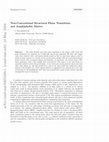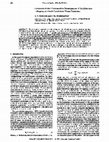Papers by Igor Erukhimovich
Journal de Physique II, 1991

The aim of this paper is two-fold. First, via a phenomenological consideration I show that, equal... more The aim of this paper is two-fold. First, via a phenomenological consideration I show that, equally with the conventional phases (body-centred cubic, hexagonal planar and lamellar), such non-conventional phases as simple cubic, face-centered cubic, well known double gyroid as well as some other phases could be stable in a vicinity of the critical point in the systems undergoing the order-disorder and order-order transition. A general phase diagram indicating the strength of so-called angle dependence of the forth vertex necessary for existence of these non-conventional phases is presented. Next, I demonstrate via a direct Leibler-like microscopic consideration of the ternary ABC block and graft copolymers that these real systems do reveal these nonconventional phases even close to the critical point. In particular, the ternary ABC block copolymers with a long middle block non-selective with respect to both side blocks are especially inclined to form the gyroid phase. A new cubic non-centrosymmetric phase and some other cubic phases are also first predicted to exist as the most stable low temperature phase instead of the lamellar one. Such a phase behavior is suggested to be common for a new class of materials we propose to call amphiphobic since their (macro)molecules consist al least of three mutually incompatible types of monomers.
Macromol Theory Simul, 2002
The European Physical Journal E Soft Matter, Feb 1, 2010
We reconsider the depletion interaction of an ideal polymer chain, characterized by the gyration ... more We reconsider the depletion interaction of an ideal polymer chain, characterized by the gyration radius R G and bond length a, and an impenetrable spherical colloid particle of radius R. Forbidding the polymer-colloid penetration explicitly (by the use of Mayer functions) without any other requirement we derive and solve analytically an integral equation for the chain partition function of a long ideal polymer chain for the spherical geometry. We find that the correction to the solution of the Dirichlet problem depends on the ratios R/R G and R/a. The correction vanishes for the continuous chain model (i.e. in the limit R/R G → 0 and R/a → ∞) but stays finite (even for an infinite chain) for the discrete chain model. The correction can become substantial in the case of nano-colloids (the so-called protein limit).

Macromolecules, 1988
A microscopic statistical theory of polyelectrolyte solutions (PES) with polyions of low linear c... more A microscopic statistical theory of polyelectrolyte solutions (PES) with polyions of low linear charge density is developed in the random phase approximation (RPA). Correlation functions of a multicomponent PES and the fluctuational electrostatic contribution to the free energy of the system are calculated. Owing to the high-polymer nature of the system these expressions differ essentially from those of Debye-Huckel (DH) type. It is shown that under certain conditions a microphase separation into oppositely charged domains takes place in PES. The phase diagram is given. The expressions for the screened Coulomb potential of a test charge are obtained. In some cases the potential oscillates. The RPA is shown to be valid for intermediate monomer or salt concentrations and is violated at very low or very high concentrations. -A24, 2223, 2232. Alexander, S.; McTanue. J. Phvs. Rev. Lett. 1978. 41. 702. Brazovsky; %'A. Zh. aksp. Te&. Fiz. 1975, 68, 175, MacKnight, W. J.; Earnest, E. A. Macromol. Reu. 1981,11,41. Ramond, P. Field Theory a Modern Primer; Benjamin: London, 1981.

Macromolecules, 1999
ABSTRACT The weak segregation theory (WST) of microphase separation in block copolymers (BC) is b... more ABSTRACT The weak segregation theory (WST) of microphase separation in block copolymers (BC) is based on the vision by Landau (1937) and seminal breakthrough by Leibler (1980) into microscopic theory of as well as the Brazovskii-Fredrickson-Helfand (1975, 1987) understanding of the corresponding fluctuation effects. The WST is especially helpful in the situation when one tries to form the well reproducible ordered morphologies, for which purpose they are to be formed as smoothly as possible. Among other new results in this field, I address the following issues: i) non-conventional morphologies and phase transitions in the bulk and confined ternary ABC block copolymers; ii) the BC phase diagram control via their chemical modification involving thermoreversible association between the different blocks; iii) the WST analysis of the non-centrosymmetric lamellar structures in the blends of the ternary and binary BC; and iv) semidulute BC solutions as photonic crystals.
Macromolecules, 1992
Some conformational characteristics of molten diblock copolymer A,B, individual macromolecules ar... more Some conformational characteristics of molten diblock copolymer A,B, individual macromolecules are calculated near the point of microphase separation as functions of reduced Flory parameter x = xN, x being the conventional Flory parameter and N = n + m-the total degree of polymerization. To carry out these calculations, Edwards' perturbative approach was generalized, "screened" monomer-monomer interaction energy being obtained by taking into account fluctuation effects beyond the random-phase approximation. Presented results verify the basic assumption of the weak segregation theory of microphase separation as to 'almost Gaussian" conformational behavior of molten diblock copolymer macromolecules and indicate the significance of fluctuation effects.

Correlated random copolymers are multiblock copolymers with a rather large polydispersity in the ... more Correlated random copolymers are multiblock copolymers with a rather large polydispersity in the block lengths: the variation in the block length is of the same order of magnitude as the average block length. The phase behavior of a melt of correlated random copolymers is qualitatively different from the phase behavior of regular monodisperse multiblock copolymers. It was already known that the system undergoes a disorder-order transition to a microphase separated state having a crystal symmetry, where the period decreases sharply with decreasing temperature. The fluctuation corrections to the phase diagram are, however, considerable. Near the order-disorder transition the profiles of the ordered phases are strongly fluctuating, giving the profiles an irregular appearance. Even if the blocks in the molecules are long, there is a large increase in the region of stability of the disordered phase. Below the mean-field spinodal this phase is strongly fluctuating as well, giving it the appearance of a microphase separated structure.
Polymer Science Series A
Finite size effects in the system of ideal cyclic polymers are studied by theoretical methods and... more Finite size effects in the system of ideal cyclic polymers are studied by theoretical methods and computer simulation. In systems with a sufficiently high density, two essentially different fractions of cycles are developed: microscopic (with short lengths as compared with the size of the system) and macroscopic cycles (with lengths comparable to the size of the whole system). In this case, when the length distribution of short cycles coincides with that known the literature within an accuracy to small corrections (the mean number of cycles with length n is proportional to n -5/2 ), long cycles are characterized by the earlier unknown and abnormally wide length distribution. The profile of the length distribution of long cycles appears to be sensitive to the types of functional groups of reacting monomers.
Computational and Theoretical Polymer Science, 1998
A complete classification of possible types of phase diagrams for associating systems of f-functi... more A complete classification of possible types of phase diagrams for associating systems of f-functional monomers capable of forming weak physical gels (thermoreversible infinite networks) is given within two different approaches. Within the Flory approach only critical solution temperatures can be shown to exist in the diagrams. The other approach accounts for the dominant role of the cyclization effects on finite scales, describes the properties of the considered system more precicely (rather than the Flory approach which deals with infinite cycles only), and produces richer phase behavior for the considered systems. Examples of phase diagrams will be discussed.
Polymer Science U.S.S.R., 1976
... USSR 15: 5, 1296, 1973) 7. VI BEKICHEV, Vysokomol. soyed. ... Curve e has two extrema at (vop... more ... USSR 15: 5, 1296, 1973) 7. VI BEKICHEV, Vysokomol. soyed. ... Curve e has two extrema at (vop)l.~=2/3]l--O/Tl~-~P~1 but curve d has a single max-imum at Ivop=~ll--O/Tl~ P~1, the state of unperturbed coils (a=l) being roached at vop=2/311--O/TI. ...
The series NanoScience and Technology is focused on the fascinating nano-world, mesoscopic physic... more The series NanoScience and Technology is focused on the fascinating nano-world, mesoscopic physics, analysis with atomic resolution, nano and quantum-effect devices, nanomechanics and atomic-scale processes. All the basic aspects and technology-oriented developments in this emerging discipline are covered by comprehensive and timely books. The series constitutes a survey of the relevant special topics, which are presented by leading experts in the field. These books will appeal to researchers, engineers, and advanced students.

AIP Conference Proceedings, 2007
ABSTRACT Using the mesoscale simulation techniques, self-consistent field (SCF) method and dissip... more ABSTRACT Using the mesoscale simulation techniques, self-consistent field (SCF) method and dissipative particle dynamics (DPD), we study microphase separation in the melt of amphiphilic/nonpolar diblock copolymers. It is shown that the phase diagram for the melt of diblock copolymers with an amphiphilic block can be significantly different from that known for the conventional model of a diblock copolymer. In particular, we find that longer nonpolar blocks may be assembled in micelles separated by a matrix of shorter amphiphilic blocks. The physical reason behind this is connected with the surface activity of amphiphilic monomer units, which forces them to be located in the regions of maximum concentration gradient. In the limit of significant amphiphilicity (surface activity), the resulting morphology corresponds to thin channels and slits of amphiphilic units penetrating through the matrix of a major nonpolar component.

The microphase separation in melts of asymmetric triblock and trigraft, periodic polyblock and po... more The microphase separation in melts of asymmetric triblock and trigraft, periodic polyblock and polygraft, and star-shaped copolymers of two types ((An)k(Bm)k and (AnBm)k) is investigated within the framework of the mean field approximation. To enable rapid comparison of the behavior of various types of block copolymer architecture, a special program 'Supercrystal" using previously calculated higher correlators of specific systems is elaborated. Surfaces of phase transition between phases with different supercrystal symmetry and a spatially homogeneous state are constructed as a function of molecular architecture and the Flory parameter x. A behavior similar to a tricritical one is observed in melts of star-shaped copolymers of the kind (A,)k(B,)k with k > 5, k being the number of arms. Phase diagrams obtained for the other systems are like the phase dmam obtained by Leibler for the molten diblock copolymer, but the temperatures of the phase transitions differ considerably for copolymers consisting of the same blocke connected in a different manner. There are limiting phase diagrams for both polyblock and polygraft systems in the limit k -OD, k being the number of blocks A,B, in a chain.

Uploads
Papers by Igor Erukhimovich